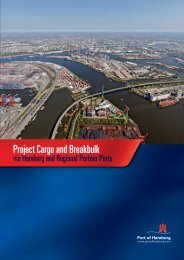Profile of Hamburg's Multi-Purpose Terminals
Profile of Hamburg's Multi-Purpose Terminals
Profile of Hamburg's Multi-Purpose Terminals
You also want an ePaper? Increase the reach of your titles
YUMPU automatically turns print PDFs into web optimized ePapers that Google loves.
Hamburg Freeport & Customs Procedures<br />
MULTI-PURPOSE TERMINALS<br />
Operator Terminal Quay Terminal Number Warehouse Total Depth<br />
Length Area Quayside Cranes Capacity Alongside<br />
BUSS HANSA Buss Hansa 840 m 30 ha 2 gantries 37,000 m 2 80,000 TEU 12.5 m<br />
TERMINAL GMBH Terminal 8 x 25-45 to cranes<br />
2 mobile cranes<br />
HHLA Fruit Centre 530 m 17 ha 1 gantry 60,000 m 2 1,000,000 t 11 m<br />
FRUCHT- UND 3 mobile crans<br />
KÜHLZENTRUM 4 carton elevators<br />
UNIKAI LAGEREI <strong>Multi</strong>-purpose 800 m 30 ha 1 container crane 1,000,000 m 2 20,000 TEU 11.5 m<br />
UND SPEDITIONS- Terminal and mobile cranes<br />
TERMINAL MBH O`Swaldkai available<br />
RO-RO-TERMINAL<br />
RHENUS MIDGARD Rhenus Midgard 500 m 135,000 m 2 2 gantry cranes (16 t) 12,500 m 2 2,5 mio. t 10.8 m<br />
RHENUS AG & Co. KG Terminal Harburg (open storage) 1 slewing crane (45 t)<br />
RHENUS MIDGARD Rhenus Midgard 400 m 155,000 m 2 2 gantry cranes (30 t) 50,000 m 2 1 ro-ro ramp 11.5 m<br />
Terminal Dradenau 1 mobile crane (100 t) 2 moorings<br />
C. STEINWEG Süd-West 1,300 m 24 ha 1 crane (40 t) 70,000 m 2 30,000 TEU up to 13 m<br />
(SÜD-WEST Terminal 1 crane (45 t)<br />
TERMINAL) 2 cranes (8 t)<br />
GMBH & CO. KG 1 mobile crane (140 t)<br />
1 hopper for bulk shipment<br />
WALLMANN & CO Wallmann 640 m 13 ha 5 cranes 70,000 m 2 250,000 TEU 13.1 m<br />
Terminal 1x140 to mobile crane<br />
Hamburg’s Freeport Area <strong>of</strong>fers manufacturers<br />
and distributors one <strong>of</strong> the most liberal tax en -<br />
vironments in Europe. The Freeport is part <strong>of</strong> the<br />
German Federal Republic, and it belongs to the<br />
Customs territory <strong>of</strong> the European Union. But,<br />
under the European Community Customs Code,<br />
third party goods entering the Freeport are treated<br />
as not yet having entered the Customs territory <strong>of</strong><br />
the Community.<br />
Goods entering the Freeport do not therefore need<br />
Customs clearance, and they can be stored in the<br />
Freeport without attracting excise duty or other<br />
taxes. Taxes are only levied if the goods leave the<br />
Freeport area for import into Germany/EU – Goods<br />
in transit to countries other than Germany are only<br />
liable for import duties when they enter their country<br />
<strong>of</strong> destination. Goods can be held in the Freeport<br />
for an unlimited period <strong>of</strong> time. Another advantage<br />
<strong>of</strong> the Freeport is that no VAT is levied on processing<br />
operations or transactions within the Freeport<br />
area. This has led many companies to set up processing<br />
operations, particularly for high-value commodities<br />
such as c<strong>of</strong>fee, tea, paper, cocoa, nuts and<br />
spices, within the Freeport.<br />
To avoid customs clearance problems in the relevant<br />
accession state, forwarders can use a socalled<br />
fiscal representative commissioned by the<br />
consignee (importer) to carry out EU customs clearance<br />
quickly and smoothly at Hamburg as the port<br />
<strong>of</strong> entry.<br />
Once goods arriving by sea have been cleared for<br />
the EU in Hamburg, e.g. by a clearing agent, they<br />
are then transported to the destination country<br />
from Hamburg as an intra-community delivery. The<br />
benefit is that customs clearance is no longer neces<br />
sary at the final destination. Only VAT appli cable<br />
in the respective country has to be paid and, in addition<br />
to saving time, this procedure also saves costs<br />
in that no T 1 dispatch document is required from<br />
the port <strong>of</strong> entry to the destination country.<br />
Goods imported into Germany from non-EU countries<br />
are in general liable to import duties (Customs<br />
duty, import turnover tax and excise duties), which<br />
are levied at a rate set by the Customs tariff or<br />
excise duty laws. Certain imports (for example, agricultural<br />
products) are exempt from duties in some<br />
circumstances, as are some goods imported from<br />
developing countries.<br />
All cargo entering or leaving Hamburg may be subject<br />
to inspection by German Customs, not only to<br />
keep a check on false Customs declarations, but<br />
also to control the import and export <strong>of</strong> illegal items<br />
such as drugs and armaments. To speed up inspection<br />
<strong>of</strong> containerised cargoes, the German Federal<br />
Customs Administration has installed a HI-CO<br />
SCAN system at the main Customs <strong>of</strong>fice near the<br />
Freeport at Waltersh<strong>of</strong>, which uses X-ray technology<br />
to examine the contents <strong>of</strong> containers entering<br />
and leaving the port. Average inspection time takes<br />
just 20 minutes, and containers are only subjected<br />
to manual searching if the X-ray examination shows<br />
suspicious items not readily identifiable on the mani<br />
fest.<br />
7



